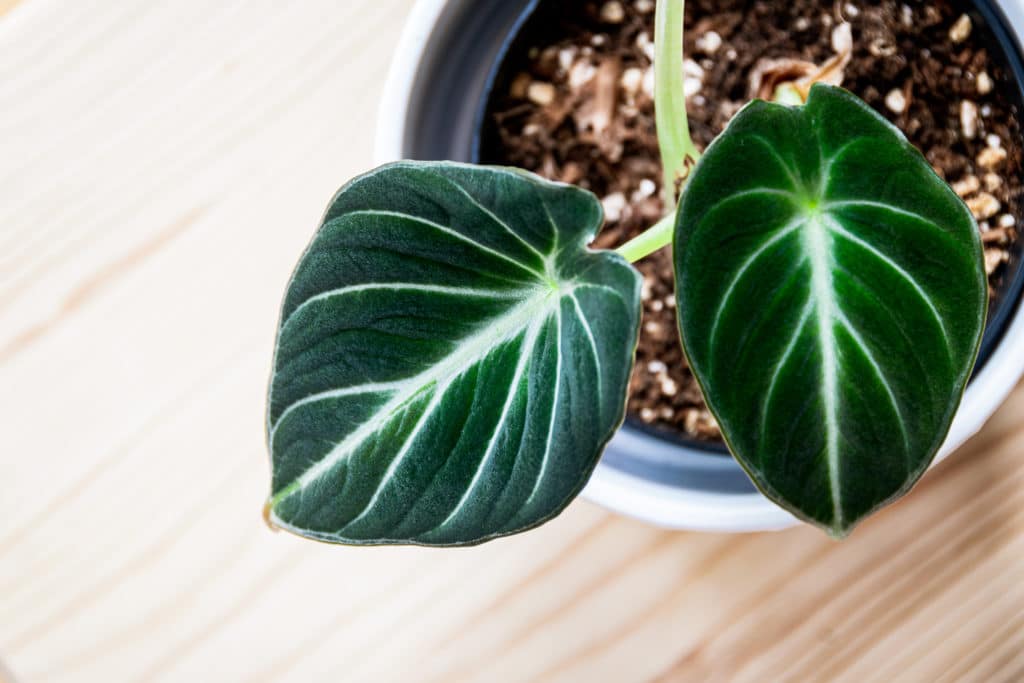
There is something mesmerizing about Alocasia Black Velvet. The deep, dark green foliage contrasted by the white venation is truly breathtaking.
It’s no wonder that Alocasia Black Velvet has become one of our most popular miniature jewel Alocasias with a compact growth habit and characteristic dark foliage.
Named for both its regal appearance and black velvety leaves, which are contrasted beautifully by the piercing white venation, Alocasia ‘Black Velvet’ makes a striking statement wherever you put it -which – as a surprisingly versatile plant – actually turns out to be quite a lot of places!
Alocasia reginula ‘Black Velvet,’ which is native to Borneo’s rainforest, has a magnificent name. The name “Black Velvet” is derived from the botanical name for Alocasia reginula, which literally translates to “little queen.”
This succulent plant, known as the “jewel alocasia,” is destined to stay tiny, delicious, and elegant throughout its existence – making it a great choice for terrarium enthusiasts and seasoned indoor plant parents alike.
The dark green foliage of Alocasia ‘Black Velvet’ is complemented by silvery veins running through them, creating a highly effective contrast to a typical green background. It’s an excellent focal piece because of its stark contrast with the greenery!
Alocasia Black Velvet Indoor Care
When it comes to Alocasia ‘Black Velvet’ indoor care, the plant is relatively easy to take care of. It enjoys bright indirect light and moist soil but can also tolerate low light levels and dry soils. In fact, this alocasia will thrive in a wide variety of conditions – making it an excellent choice for both beginning and experienced indoor gardeners alike!
Water your alocasia black velvet regularly, ensuring that the potting mix remains evenly moist but not soggy. Feed monthly with a balanced liquid houseplant fertilizer during the growing season (spring through fall). Allow the top inch or so of soil to dry out between waterings.
Alocasia ‘Black Velvet’ is tolerant of neglect, but will look its best with regular watering and fertilizing. Prune as needed to maintain the desired shape.
Overall, Alocasia ‘Black Velvet’ are relatively straightforward plants to take care of – making them a great choice for anyone looking for an easy-to-care-for indoor plant that will add some elegance and sophistication to their home or office!
Plant Type: Foliage
Lighting: Bright indirect light
Temperature: 55-86°F (12-30°C)
Watering: Infrequent, moderate moisture
Humidity: Medium – high humidity (40-70%)
Growth: 10-15 inches
Alocasia Black Velvet Lighting
Alocasia ‘Black Velvet’ will flourish in a location with lots of indirect light. Indirect light can be provided from a North- or East-facing window. Alocasia black velvet will also grow in low light levels, but may lose its variegation in these conditions.
Alocasia Black Velvet Temperature
The ideal temperature range for alocasia black velvet is 55-86°F (12-30°C). Temperatures below 50°F (l0°C) or above 90°F (32°C) can cause damage to the plant.
Alocasia Black Velvet Watering
Water your alocasia black velvet regularly, ensuring that the potting mix remains evenly moist but not soggy. Do not allow the top inch or so of soil to dry out between waterings.
Alocasia Black Velvet Humidity
Humidity is a very important consideration for Alocasia Black Velvet. While Alocasias can tolerate dry air, they do best when the relative humidity is 40-70% and the soil always feels moist to the touch.
You can increase your Alocasia’s humidity by misting it regularly or setting its pot on top of pebbles that have been immersed in water. If you notice brown leaf tips or other signs of stress caused by low humidity levels, try increasing them as described above.

Alocasia Black Velvet Soil Requirements
Alocasia Black Velvet prefers soil that is loamy and rich in nutrients. At the same time, Alocasias do not like to have their roots sitting directly on top of wet soil as this can lead to root rot.
Add some drainage material such as perlite or coarse sand when planting alocasia black velvet so excess water will flow out instead of staying around its roots.
A general-purpose potting mix works well for alocasia black velvet plants since they are tolerant of many different soil types.
However, you should always try to ensure that your alocasia’s potting mix contains plenty of organic materials (such as peat moss) and does not contain any large pieces of bark or wood chips which may impede drainage.
Alocasia Black Velvet Fertilizer
Feed alocasia black velvet plants monthly with a balanced liquid houseplant fertilizer during the growing season (spring through fall).
Alocasia ‘Black Velvet’ is tolerant of neglect, but will look its best with regular watering and fertilizing. Prune as needed to maintain the desired shape.
Seasonal Issues
Artificial heat may be harsh on your Black Velvet. Artificial warmth removes moisture from the air, putting them at risk of leaf discoloration or a devastating spider mite infestation.
Offering a humid environment in the winter is a smart strategy.
Repotting
Alocasia Black Velvet can be repotted at any time during the year, but prefer to do so in the spring. When repotting, use a pot that is only one size larger than the current pot and add fresh potting mix to the top.
Alocasia Black Velvet does best when grown in small pots. They like being slightly rootbound rather than having their roots exposed to too much soil.
Black Velvets have a restricted root system. If there is too much vacant soil surrounding the rootball, the plant will be unable to cope with it. Root rot can quickly kill the plant if there is too much moisture.
Pruning
Pruning is simple; all you have to do is remove dead leaves.
Discolored leaves will wilt and fall off over time, although you may expedite the process by pruning away only a portion of each leaf.
The middle of the plant is where new development occurs. When new growth appears, older leaves frequently drop away.
Gently tug a straggling leaf to discover whether it’s been torn from the plant. Don’t pull harshly or rip it, but instead use rubbing (isopropyl) alcohol to sterilize your cutting tools and perform the operation close to the root.
Alocasia Black Velvet Care Tips
- When the plant is ready to bloom, it may seem miserable; it might have fallen into dormancy as a result of tension. Allow it to rest and water it a little. It might be stronger than ever before.
- If the light fades or the soil becomes too dry, your Black Velvet may go dormant. If you don’t want the plant to go dormant, maintain conditions as they were during the growing season.
- The lush, dark leaves of the Powdery Blue Velvets are often bushy, but as new ones grow, old ones fall away.
- A weekly wash might assist with spider mites.
- They require time to become accustomed to their new surroundings after relocation. They can’t be shipped effectively, either, but will recover with excellent Alocasia Black Velvet care.
- Although begonia leaves are smooth, they attract dust, so clean them with a moistened cloth on occasion. They break rather easily; be cautious!
Common Care Problems
Yellow Spots – Irregular watering – too much or insufficient water – can cause leaves to yellow and have pockmarks. Heavy soil that retains moisture might be a culprit. Take this seriously: Yellowing on one side of the leaf may indicate a health problem.
Brown Leaf Edges – Brown, crispy edges may appear on a plant that is suffering from humidity.
Brown Leaf Tips – Browning of the tips can result from underwatering and fertilizer burn.
Brown Spots – Brown spots are caused by a variety of factors, including fungal infections or pests.
Leaf Decline – The leaves become discolored and fall as a result of dormancy. Don’t be alarmed, and don’t give the plant more water or fertilizer. The plant may recover once the conditions are optimal.
Light-Colored Leaves – The leaves are pale, becoming darker with age. The leaves can also be bleached by strong light.
Drooping Leaves – Drooping is a common occurrence for Alocasia Black Velvet. It’s most often due to a water issue, but other causes of worry can induce your plant to droop.
